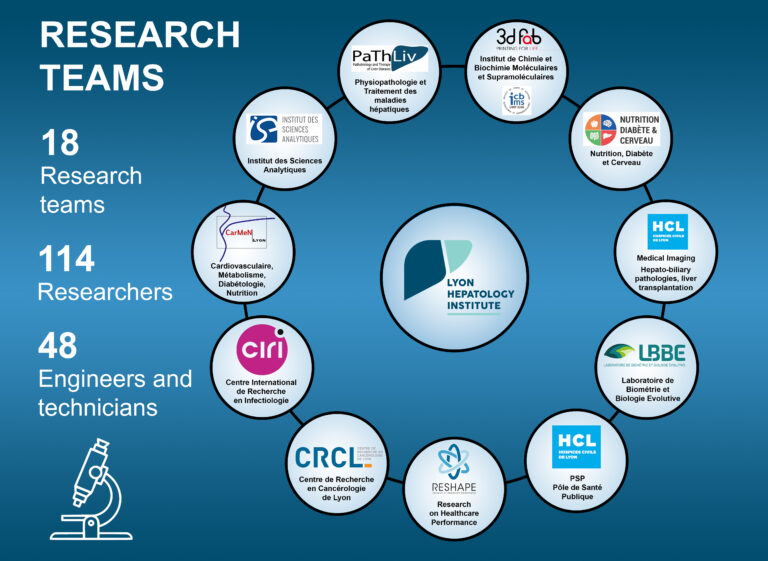Accueil » The research teams
The research teams
Our institute gathers 18 research teams, within 11 units

Hepatitis Viruses and Pathobiology of Chronic Liver Diseases
This team aims at understanding the pathophysiology of virus-induced liver pathology involved in the progression towards cirrhosis and hepatocellular carcinoma. Through basic science and translational research, we seek to: i) decipher the molecular mechanisms of HBV cccDNA chromatinization and persistence; ii) identify novel targets to cure HBV/HDV infection; iii) characterize novel non-invasive biomarkers of the hepatic reservoir of the virus to monitor novel therapies; iv) understand the metabolic perturbations and oxidative stress induced by HBV, HDV and HCV and their potential role in HCC development, v) unravel the role of the interplay between inflammation, oxidative stress, apoptosis and cellular transformation across liver disease etiologies.
Epigenetics, microenvironment and liver cancer
This team research interests focus on the virological, metabolic, and immunological determinants of chronic liver disease progression and hepatocellular carcinoma (HCC) development using both basic research and translational approaches. Highlights include: i) characterization of epigenetic changes in virus- and non-virus-related HCCs and the potential of histone methyltransferases as HCC epi-drivers/ therapeutic targets; ii) multiomics approaches to liver inflammation characterization in NAFLD; iii) circulating HBV RNAs assays to assess curative treatments for hepatitis B and D; circulating miRNAs as innovative biomarkers to predict survival in decompensated cirrhosis, HCC risk, and NASH progression.
Apoptosis, cancer and development
The team, located on the 5th floor of the Cheney B building of the Centre Leon Berard research campus, is investigating the concept of dependence receptors and is more specifically investigating the physiological and pathological role of the pair netrin-1 and its dependence receptors DCC/UNC5. Along this line, the team has demonstrated that netrin-1, a developmental cue, is up-regulated in the vast majority of human cancers including Hepatocellular Carcinoma (HCC). Together with its spin-off NETRIS Pharma, they have generated a netrin-1 blocking monoclonal antibody that is currently being tested in various phase II trials including in patients with HCC.
Ribosome, Translation and Cancer
Fourty years after the demonstration that ribosomes were the effectors of translation, new evidence suggests that we are entering an exciting novel ribosomal era in which the “passive” role of ribosomes in gene expression regulation is challenged. The Team of JJ Diaz has published ground-breaking studies recognized in the “ribosome field” demonstrating that ribosomal RNA (rRNA) are the major actors of ribosome specialization. The Team has unraveled rRNA plasticity and demonstrated that this plasticity provides functional specificity to human ribosomes. During tumor initiation and progression ribosomal plasticity regulates intrinsic translational activities that favor translation of several genes playing key roles in cancer development and in resistance to anti-cancer treatments. Ongoing projects are addressing the relevance of ribosomal plasticity for hepatocellular carcinoma.
Cellular Senescence, Cancer and Aging
Cellular senescence is involved in many diseases, including liver diseases (NAFLD, HCC), linked to aging, viral infection or lifestyle (obesity, alcohol, cigarette smoking). It can also impact allograft survival. The "cellular senescence, cancer and aging" team is interested in better understanding mechanisms regulating cellular senescence from cell cycle arrest to composition of its secretome that strongly impact tissue (dys)functions. The goal is to identify targets to develop serotherapies (senomorphic and senolysis) to prevent/improve age-related diseases, including liver diseases.
Interplay between HBV and HDV and liver host factors
The objective of our team are to investigate the interactions between HBV/HDV viruses with host-factors in liver cells (i.e., hepatocytes, liver resident innate immune cells) in order to better (1) understand the early steps leading to viral establishment and persistence, (2) characterize viro-induced mechanisms of liver pathogenesis using relevant and newly-developed animal models, (3) identify novel targets/biomarkers for the development of novel host-targeting antiviral agents (HTA), which could also be interesting to prevent pathogenesis progression and onset of HCC. Our research program, which includes interconnected basic and translational research, is divided into three main axes : 1) Nuclear functions of HBV core protein in link with novel host factors & inhibitors of these functions; 2) Interplay between HBV, HDV, and innate immune responses; 3) Interactions between HBV/HDV and NF-kB pathways: from understanding to preclinical development of NF-kB inducers.
Viral Infection, Metabolism and Immunity
The link between metabolism and immunity has recently been discovered thanks to « omics » and transdisciplinary approaches at the origin of the immunometabolism concept. This team is engaged in the study of metabolic pathways involved in the control of antiviral innate immunity and virus replication with a focus on respiratory (Influenza, Nipah, measles) and hepatotropic viruses (HCV, HBV, HDV). Beyond generating basic knowledge, our objective is to develop innovative anti-viral therapies targeting cellular pathways rather than the virus itself. Combining interactomic, metabolomic, transcriptomic and chemo-biological approaches, the team has identified several metabolic pathways and candidate molecules for treating chronic (HBV, HDV) and acute viral infections (Influenza).
Normal and pathogenic B cell responses
This team has recognized expertise in basic molecular mechanisms involved in B cell/antibody response in both physiologic and pathologic contexts, more specifically in organ transplantation. Within the frame of the IHU EVEREST project, we will use a translational approach combining experimental models and in-depth analyses of human samples to i) decipher the impact of ischemia/reperfusion injuries on recipient’s immune responses against liver allograft, and ii) understand the immunopathology of antibody-mediated rejection of liver allografts.
Mitochondria-ER interactions and signalling in metabolic health and diseases
The MERISM team is a biomedical research team composed of basic scientists (6 researchers and 2 assistant professors) and clinicians (4 PU-PH and 2 PH) in the field of cellular biology and hepatic metabolic diseases. The general objective of the MERISM team is to better characterize the functional roles of endoplasmic reticulum-mitochondria contact sites (called mitochondria-associated membranes, MAMs) in the control of glucose and lipid homeostasis and to identify new actors or regulators of MAMs that could represent new targets to improve metabolic diseases, in particular type 2 diabetes, NAFLDs and / or dyslipidemias.
Diet and Food Matrix in Obesity and Metabolic Diseases
The DO-IT team explores mechanisms related to the interaction between diet and gut microbiota to identify new biomarkers and nutritional and/or therapeutic strategies to prevent or treat metabolic diseases. Several members of CarMeN DO-IT team with complementary expertises to reach the objectives are involved in EVEREST: Dr David Cheillan in lipidomics (PH expert in sphingolipidomics, head of the SL platform), Dr Karim Chikh (MCU PH expert in bile acid analysis and metabolomics), and Julie-Anne Nazare (MCU CarMeN, Head of our Human Nutrition Research Center), notably via the joint METANUTRIBIOTA platform.
Nutrition, Diabetes and the Brain
The "Nutrition, Diabetes and the Brain" lab is organized as an unique team with two coordinated projects (Glycogen Storage Disease Type I/diabetes), bringing together 3 full time permanent researchers (G. Mithieux, A. Gautier Stein, F. Rajas) and a total of about 15-20 persons. Other permanent positions are 2 engineer assistants from Inserm. This composition is currently completed with people with non-permanent positions comprising, a post-doctoral fellow, 4 PhD students and several engineer assistants, the number of which might vary according to funding sources. Our way of working is centralized, notably the management of the mouse lines by a dedicated person for the whole laboratory.
Pathophysiology of immunosuppression associated with systemic inflammatory responses
Through a translational research approach, The PI3 team investigates the pathophysiological mechanisms sustaining the development of marked immunosuppression after various injuries (sepsis, trauma, burns, and surgery). One objective is to develop innovative biological tools for the monitoring of patients’ immune status. Severe cirrhotic patients are hypothesized to present similar immune alterations as those seen in sepsis. Our contribution in EVEREST is to translate our expertise in acquired immunosuppression monitoring to liver diseases, especially in patients before and after transplantation.
Biological Analysis by Mass Spectrometry
The ISA team has a recognized expertise in development of innovative analytical methodologies in multi-omics for biomarker research (RHU, ANR JCJC), upstream research activities on instrumental and MS methodological developments for the structural and quantitative analysis of biomolecules, MALDI imaging with ion mobility applied to model organisms, and expertise on data science and data management. ISA members have been involved as coordinator or partner in several national (ANR JCJC, ANR PRC, RHU IdBIORIV) and regional (ICL, CPER, IDEX Lyon-St Etienne) projects. ISA provides its expertise to EVEREST for the establishment of spatial multiomics technologies for translational research in hepatology.
Enzymatic Engineering, Biomimetic Membranes and Supramolecular Assemblies
UCBL-3dFAB platform, created in 2015 and coordinated by C. Marquette, is a unique European academic platform gathering a wide range of 3D printing & bioprinting technologies to develop and deploy 3D printing for healthcare. Its specific 3D printing technologies and associated expertise (cell biology/rheology/bioink formulation/tissue culture/bioprocess) are made available for academic or industrial partners. UCBL-3d.FAB research activities on 3D printing technologies and their healthcare applications bring strong know-how on biomaterial formulations to reach desire rheology allowing high cell viability and phenotypic characteristics while micro-extrusion printing or ink-jetting. The team is internationally recognized for its advances in tissue bioprinting, especially for its applications to skin bioprinting in intraoperative areas for burn injuries and for its dm3 scale macro-porous and vascularized conjunctive tissues. The team has initiated investigations for the 3D printing of hepatocytes and other liver cells, and will contribute actively by the generation new 3D cell culture models for the liver.
Biostatistics Health Group
The Biostatistics Health Group (Head, M Rabilloud) of the Statistics and Modelling for Health Sciences department (Head, P Roy of the Laboratory of Biometry and Evolutionary Biology (LBBE), and the Service de Biostatistique-Bioinformatique (Head, D Maucort-Boulch) of the Hospices Civils de Lyon work together to develop models and algorithms for diagnostic, prognostic and theranostic statistical modeling in clinical research, for epidemiological studies, and for bioinformatic investigations of omics and multi-omics. LBBE is developing five main research axes that are relevant to EVEREST: 1) study of Incidence, Mortality, Survival, 2) Modelisation of patients trajectories, 3) Inference methods in medical decision making, 4) Precision Medicine: Identification of Biomarkers and Bioinformatics, 5) Statistical methods for clinical trials. The team will be actively involved in the Institute's research projects for multi-omics and biomarker studies, clinical study design and result analysis, and AI-based approach towards precision medicine in hepatology.
Social Psychology Unit
The Health social psychology team works to explain, predict and change health knowledge, beliefs and behavior in order to improve disease prevention and follow-up of patients. With a participative or community-based approach and a multidisciplinary perspective, the team designs transversal, interventional or longitudinal studies with patients, relatives or medical staff. We develop a comprehensive approach to understanding the patient’s perspective, in order to design studies relevant the concerned patient populations and build adapted interventions. The team will bring its expertise to EVEREST through the investigation of key factors representing bottlenecks in access to care, especially in vulnerable populations, and in the retention in the care system in patients with chronic liver diseases.
RESearch on HealthcAre Performance
The RESHAPE (RESearch on HealthcAre PErformance) Unit U1290 is a Public Health research unit operating under the dual supervision of Université Claude Bernard Lyon 1 and INSERM, in partnership with the Lyon University Hospitals (Hospices Civils de Lyon and Centre Léon Bérard). The team's research focuses on the performance of health services and health professionals. This work integrates real-life observational studies of population health and health services drawing from large local (EDS HCL) and national (PMSI-SNDS) data warehouses. The team will thus contribute to the Institute through studies on the impact of EVEREST on innovation in population health and care outcomes.
Health Economic Evaluation Service
The Health Economic Evaluation Service (SEES) provide the entire HCL community and its territory, with the skills and expertise necessary for the implementation of research projects in the field of medico-economic and care pathways evaluations. Economic evaluations are mainly cost/cost-effectiveness/cost-utility studies and budget impact analyses, based on specific collection of data or the use of medico-administrative databases (Health Data Hub). SEES will contribute to EVEREST through the evaluation of innovations in chronic liver diseases with: 1) cost-utility and cost-effectiveness analysis, ii) budget impact analysis, iii) multidimensional assessment of care pathways; iv) Health Technology Assessment.


